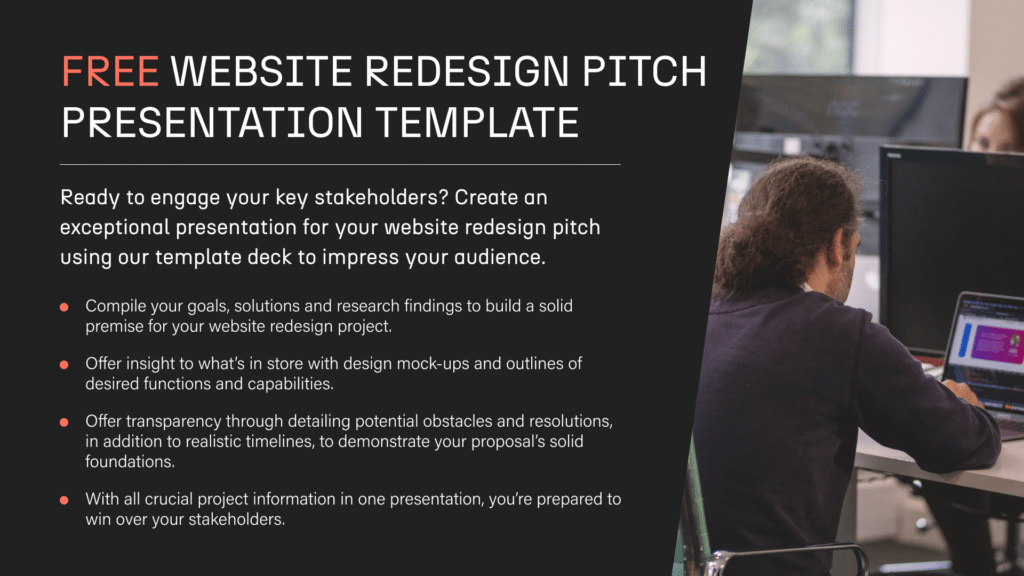How to Gain Buy-In for a Website Redesign [with Pitch Deck Template]
Previously on the Banc blog, we’ve talked a bit about creating a web design statement of work and writing up a board pack report. Both elements play vital roles in getting digital projects off the ground. Stakeholder buy-in is another important piece of a project’s success that everyone should be carrying out at the outset, however they could well take some convincing before you get the green light.
So, in what is now the third part of our unofficial “digital folk persuading higher ups” series, we’ll take a look at why getting buy-in for a website redesign is so essential, how to get buy-in from difficult stakeholders and show you some top tips for how to present a project plan to stakeholders.
We’ve even including a free, downloadable pitch deck presentation template to help you get it right, first time.
Quick Navigation
- Why stakeholder buy-in is important
- How to get stakeholder buy-in
- Presenting your project
- Stakeholder presentation tips
Why stakeholder buy-in is important
Stakeholders might not know the ins and outs of the work you’re involved with, but one thing’s for sure: they have an undeniable sway within your business. Getting them on your side is going to be absolutely crucial. With stakeholder buy-in, your website redesign stands a greater chance of success, ensuring that senior staff are clued up on the project’s benefits and aims from the very beginning. It lets them connect to the project in a more emotional way, giving you a chance to target not just their heads, but their hearts too.
How to get stakeholder buy-in for your project
Stakeholder buy-in takes time and effort, but with the help of the tips below, you can make the process go a lot smoother than without. Let’s take a look at them in more detail…
Clearly outline the reasons or need for the project
Your site’s redesign stands a far better chance of buy-in if you can properly justify it beyond “it’s going to look nice and shiny”. It doesn’t matter how many fancy bells and whistles you want it to have, if your stakeholders can’t see the point of it, your project will most probably be DOA.
Before you do anything else, identify the purpose behind your project – and make sure everyone on your team understands them too. Ask yourself why the new site needs to exist, what it can bring to the company that the current site can’t, and get a handle on what you believe could be achieved with the new improvements.
To do this, you’ll need to do a fair bit of research. This is where the statement of work document mentioned above comes into play. Essentially, the more you’re able to articulate what it is you want to do, the more you’ll be able to achieve that all-important buy-in.
Engage your stakeholders
You’ll want the project to be on your stakeholders’ radar as early as possible. Not only are they likely to be busy, but by including them at this stage of the project, you can integrate their opinions and insights into your ground-floor vision before things progress.
There’s a chance you won’t necessarily see eye-to-eye on everything, but through this two-way communication, the trust and transparency you create is something that’ll linger long in their mind – and that’s something that’ll be appreciated, and encouraged, as the project moves onwards.
Demonstrate the benefits and what success will look like (including the ROI)
As much as you want to appeal to their hearts, many stakeholders love thinking with their heads. They want numbers, figures, and statistics – and lots of them. When you approach them, make the results of the project clear, especially how it might affect the business’ bottom line.
Specifics are good, but rather than focusing too precisely on departmental objectives, cast that net wider: demonstrate the benefits as they relate to your business’ wider objectives. Likewise, make sure you come equipped with answers for questions such as:
- How profitable will this be?
- How much more revenue is it going to generate?
- What KPIs will you be measuring success with?
- Why should we invest in this project?

Identify any potential obstacles (and how they can be avoided)
As much as stakeholders will want to hear about the project’s benefits, they’ll want to know that you’ve done your research regarding alternatives and contingencies should any obstacles get in your way – and what you’re going to do to avoid these pitfalls.
Likewise, there’s every chance that they’ll be ready to poke holes in your proposal. Rather than going on the defensive, use these criticisms as an opportunity to refine the project and search for better solutions. While you’ll have your original vision, don’t be so near-sighted that you’re totally unwilling to compromise over the course of the project.
Outline timelines and expectations
Your stakeholders will be expecting a lot from your plans, so make sure you’re managing those expectations. If you’ve given them a timeframe for delivery, for instance, then it’s vital that you stick to that delivery as much as possible. Like we said, your stakeholders might not always be the most technically minded; there’s a good chance they’re unaware of just how long a website takes to build.
Whether it takes you a few months or an entire year to complete, make sure you’re up front with them about the duration from the very beginning.
Presenting your project
Preparation is one thing, but knowing how to pitch a website redesign is another. Thankfully you’ll have done most of the legwork at the prep stage, now just need to bring all your findings together into a presentation that’s going to well and truly knock your stakeholders’ socks off.
Creating your presentation
Creating a presentation can be a bit of a headache if you’ve never done it before – or if design skills aren’t your strong suit.
Not to worry, we’ve created a handy downloadable template for you to use. It features all the elements you need to pull off your pitch without a hitch – just fill in the relevant details and information and you’ll be good to go.

Ready to make a start? You can grab your downloadable presentation template right here.
Powerful tips for your stakeholder presentation
Cut to the chase
Stakeholders are, more often than not, time-poor. They’re used to being pulled in all kinds of different directions and their schedules are always stocked up. So, while your research will have been in-depth, the delivery of your findings should be succinct but powerful.
When it’s time to present, be sure to emphasise the key messages right at the start, outline the problems you want to solve and highlight the results in ways they’ll fully understand.
Speak to their interests
It’s always a good idea to read the room; the last thing you want to be doing is finding yourself in waffle mode – especially if what you’re talking about doesn’t apply to your stakeholders’ roles. Your in-depth analysis of the business’ branding might seem like a showstopper, but it’s more than likely going to go completely over the head of the CTO.
Our rule of thumb: if you know they like quantitative results, keep their attention by sticking to the numbers.
Have a high-level overview slide
Whether it’s a slide or a printout they can take away afterwards, something that provides an at-a-glance summary of the key points is going to go down well with stakeholders. Plus, if your audience can see your heavyweight stats and findings from the get-go, you’re more likely to capture their imagination – and hear out the rest of what you’ve got to say over the course of the presentation.
Looking for a team of designers, developers and creatives who can revamp your website from the ground up? Head to our homepage or get in touch on 0345 459 0558 and we’ll put our expert re-design skills to work for you and your business.



